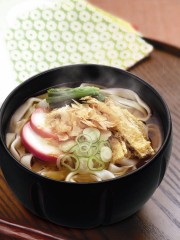|
|
Interesting Facts About Kishimen Noodles
What is Kishimen?

- Kishimen noodles are wider than conventional noodles.
- Dried noodle quality standards require that noodles are no less than 4.5mm wide, no greater than 2.0mm thick, and are made from wheat flour.
- They are usually eaten with soy-based sauce flavored with bonito and kelp stock and topped with kamaboko fish paste, spinach and bonito shavings.
- Flat noodles taste best when mixed and eaten with soup.
Origins of Kishimen

- Blessed with the clear waters of Kiso River and ideal climate conditions, Owari Plain has long been a noodle producing area. Among the local products, Kishimen noodles have widespread popularity among food aficionados throughout Japan as a representative product of Owari Nagoya.
- There are numerous stories about the origins of Kishimen. It is said to have originated from flat noodles that were served with pheasant ("Kiji" in Japanese) meat for a lord in Nagoya, thus giving the name "Kijimen;"another story is that it derived from "Kishumen" from the Kishu area; and there is another story that the vassals of Takeda Shingen during the Warring States Period introduced "Himokawa" and "Hoto" flat noodles to Owari from the Kanto region.
- The existence of these different stories, without any one established theory, adds to the mysterious appeal of "Nagoya Kishimen" noodles.
- Following repeated research aimed at serving delicious yet inexpensive Kishimen noodles while adhering to tradition, Nagoya Kishimentei has finally established a vaunted manufacturing method and flavor that is in no way inferior to hand-made noodles.
- This Kishimen may be called an entirely natural food that is finished with completely "old-style" color and flavoring.
|
|









 商品お届けの際、運送会社(ゆうパック/ヤマト運輸)のドライバーへ現金にてお支払いください。
商品お届けの際、運送会社(ゆうパック/ヤマト運輸)のドライバーへ現金にてお支払いください。

